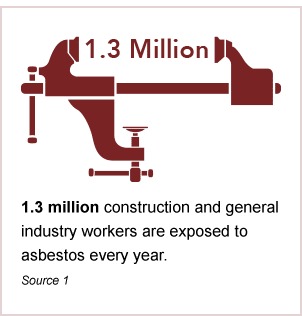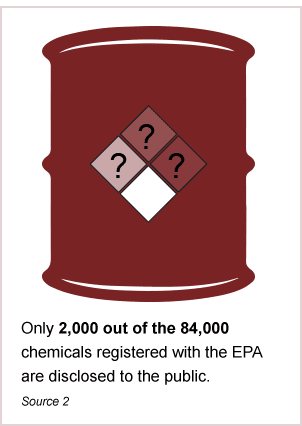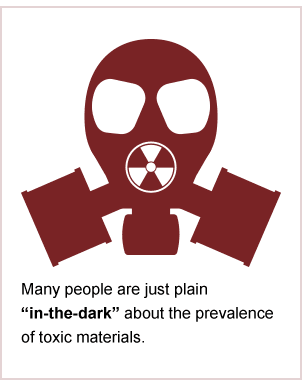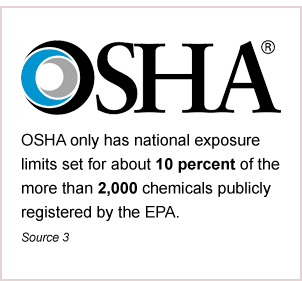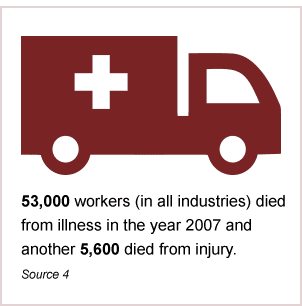An experienced bricklayer, Chris Johnson took a job restoring old apartment buildings in Rome, New York in 2004. Standing high atop a hydraulic lift, he cut and chiseled his way through the facades of 3 buildings as debris swirled around him in a growing storm. The impenetrable cloud of dust first obscured Johnson’s vision, and soon covered his face and then his entire body – so much dust clung to him that when Johnson took the lift back down to the ground, his co-workers were quick to nickname him “Dusty.”
Johnson and the rest of his crew had access only to cheap paper masks for lung protection and a single, broken respirator to share between the lot of them. Johnson would have preferred a safer, alternative method of removing the bricks called “wet-cutting,” but he wasn’t authorized to use this technique because the project manager feared it would create too much of a mess.
Shortly after finishing work on the apartment buildings, one of Johnson’s lungs collapsed. At only 30-years-old, he had developed the life-threatening condition, silicosis. He lost much of his ability to breathe and struggled to maintain his weight before enduring 2 painful and invasive medical procedures. His health has since stabilized, but his condition will never be cured.
Who Works on a Building?
A Partial List of Construction Trades
- Abatement Contractors
- Brickmasons, Blockmasons, Stonemasons, and Tile/Marble Setters
- Carpenters
- Electricians
- General Contractors
- Heavy Equipment Operator
- Insulation Installer/Hazardous Material Handler
- Iron Workers
- Painters
- Paperhangers, Plasterers, and Stucco Masons
- Pipelayers, Pipefitters, and Steamfitters
- Plumbers
- Roofers
- Sheet Metal Worker
- Welders
Meet the Killers
When someone says the word “construction worker” images of men with jackhammers and hard hats pop into mind, but really, many types of contractors are involved in a single project. Every part of a house or building – floors, roofs, windows, plumbing, electrical wiring, frames, and foundations – are all installed and constructed by a specialist.
Workers across every subfield of construction are exposed to toxic chemicals, substances, and hazards. Asbestos alone is snuck into kitchen floors, roofing materials, and insulation – and that’s especially true for houses made before the early 1980s. A recent study out of Sweden found that, while exposure risks can be minimized, “safe handling of asbestos is a very difficult or even impossible task in the construction industry.” In many cases, these workers don’t even know what chemicals they’re being exposed to because only 2,000 out of the 84,000 registered with the EPA are disclosed to the public. For every substance that’s regulated, there are literally thousands that are not.
Federal agencies like OSHA and the EPA lack the authority to sanction corporate chemical manufacturers and as a result, have consistently failed to protect workers. OSHA’s safe exposure levels for many hazardous substances haven’t been updated in nearly 50 years, making them highly inaccurate and out-of-date. OSHA is the first to admit its ineffectiveness: it conducted a study and found that workers in all industries have a 6 in 10 chance of developing cancer from toxic chemicals, even when working within the so-called safe exposure limit.
Resulting from this cocktail of corporate corruption and incompetence, construction workers and homeowners suffer. Long after the hammers and saws are packed away, the same deadly substances that threatened construction workers are now part of the home, secreted away in its walls, floors, and ceilings where it may threaten generations of families to come.
On the Job Site and In Your Home:
Where Toxic Materials Hide
“It’s Still Here”: Ignorance of Exposure Risks Can Kill
Bruce Hackett is a toxic substance abatement contractor based in Portland, Maine, where he and his crew remove harmful materials from old schools, businesses, and homes. Hackett’s contribution to the construction industry is protecting workers who don’t have the training or equipment to safely handle hazardous materials. This makes his line of work among the most dangerous of all those in the construction field. It also makes him a bit of a hero.Bruce also teaches safety classes to contractors and homeowners – during his classes, he will see contractors turn “completely white” in the face when he explains that old boilers and kitchen floors are often filled with asbestos. When he calls on these scared individuals, they admit that they’ve recently removed flooring without protection. When ripping up floors or tearing down walls, construction workers are focused on doing a quick, efficient, and high-quality job. Why? They want the praise of their employers and clients, but also the undeniable gratification that comes from a job well-done. What these men are not wondering is what microscopic dangers lurk within the materials they are cutting, removing, ripping up and out, and replacing.
 According to Hackett, many people are just plain “in-the-dark” about the prevalence of toxic materials. “It’s not ignorance because they’re stupid,” Hackett says, “but because the information doesn’t get out there, [especially] to the homeowner.” Hackett meets disbelieving clients who assume that asbestos “‘[is] from my grandmother’s era.’” Hackett explained, “Everybody’s under the misunderstanding that 1: [Asbestos] can’t be sold in products today and 2: That it’s no longer around. It is. It’s still here.”
According to Hackett, many people are just plain “in-the-dark” about the prevalence of toxic materials. “It’s not ignorance because they’re stupid,” Hackett says, “but because the information doesn’t get out there, [especially] to the homeowner.” Hackett meets disbelieving clients who assume that asbestos “‘[is] from my grandmother’s era.’” Hackett explained, “Everybody’s under the misunderstanding that 1: [Asbestos] can’t be sold in products today and 2: That it’s no longer around. It is. It’s still here.”
3 Waves of Asbestos Disease
Forward-Thinking Contractors Take Safety into Their Own Hands
Owner and president of INS Insulation in Portland, Maine, Charlie (who preferred to keep his last name anonymous) understands that safety is a shared responsibility between many parties. However, on a day-to-day level, contractors and project managers must insist on stringent standards and practices.
“We’re a very big believer in certification,” Charlie explained. He recommended that all contractors and construction workers entering the industry, at the very least, attend the OSHA 10-hour safety course, but preferably enroll in the 30-hour course. He was also adamant on the importance of Personal Protective Equipment (PPE). “We always use a respirator with supplied air – that’s a very critical point,” he said.
Charlie is fixated on the details and insists that his employees do the same. For this reason he quizzes them on OSHA regulations and key safety points, often going above and beyond the federal requirements. “I train the guys interactively,” he said. “I ask the same question throughout the day – 10 times.” As a result, none of Charlie’s employees have suffered illness from asbestos or any other toxic chemicals. His business is proof of Bruce Hackett’s notion that better worker safety is not an impossibility, but it does require hard work and a commitment to education.
Federal Agencies’ Ineffective Regulations Are Hurting America’s Workers
While Bruce Hackett and Charlie make it a point to exceed federal requirements and stay updated on most every development in their field, the Occupational Safety and Health Administration is a total mess. OSHA’s national exposure limits are supposed to represent the maximum amount of “safe” chemical exposure a worker can endure on a job site; however, many of these limits haven’t been updated since 1970. 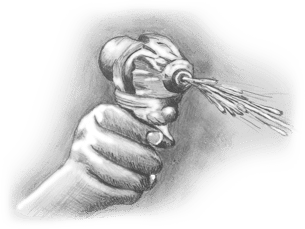 In fact, the agency has only set 470 limits in the entirety of its 45-year existence. OSHA only has limits set for about 10 percent of the more than 2,000 chemicals publicly registered by the EPA. Considering that there are another 80-some thousand non-registered chemicals, OSHA’s safety limits are akin to fighting a 5-alarm fire with a squirt gun. This is a huge problem considering that responsible contractors like Bruce and Charlie rely on OSHA information.But the fault doesn’t fall entirely on OSHA’s shoulders. The agency has tried to regulate chemical use, both individually and by means of sweeping initiatives, but its efforts have been shot down by a Congress bought and paid for by corporate executives. In many cases, OSHA must set regulations one chemical at a time, a process that makes effective rule making slow at best, and impossible at worst. Add to this the fact that – unbelievably – OSHA’s staff has actually shrunk in the past 30 years (compared to other health agencies like the EPA, which has grown by as much as 24 percent) and it’s no wonder why workers must struggle with constant danger and little protection.
In fact, the agency has only set 470 limits in the entirety of its 45-year existence. OSHA only has limits set for about 10 percent of the more than 2,000 chemicals publicly registered by the EPA. Considering that there are another 80-some thousand non-registered chemicals, OSHA’s safety limits are akin to fighting a 5-alarm fire with a squirt gun. This is a huge problem considering that responsible contractors like Bruce and Charlie rely on OSHA information.But the fault doesn’t fall entirely on OSHA’s shoulders. The agency has tried to regulate chemical use, both individually and by means of sweeping initiatives, but its efforts have been shot down by a Congress bought and paid for by corporate executives. In many cases, OSHA must set regulations one chemical at a time, a process that makes effective rule making slow at best, and impossible at worst. Add to this the fact that – unbelievably – OSHA’s staff has actually shrunk in the past 30 years (compared to other health agencies like the EPA, which has grown by as much as 24 percent) and it’s no wonder why workers must struggle with constant danger and little protection.
Just a few months ago, the head of OSHA, David Michaels, admitted, “With a few exceptions, OSHA’s standards to protect workers from chemical exposures are weak and out-of-date, or simply non-existent.” Michaels went on to describe OSHA’s plight as one of “regulatory Whack-a-Mole,” because just as OSHA begins to regulate one substance, private corporations find or create a very similar alternative substance for which there are no regulations.
Just how deep do Big Chemical’s pockets go? In 2015 alone, chemical-industry lobbying topped $54 Million. This number – shockingly – marks a downward trend from an all-time high in 2014, when the industry spent $65 Million donating to the election and re-election campaigns of America’s politicians. Organizations like DOW Chemical, the American Chemical Council, DuPont Co., Koch Industries, and Goodyear Tire & Rubber continue to pour millions of dollars into the wallets of our elected officials in an effort to keep their cheaper (and dangerous) chemicals in commerce. And the result? Federal policy stays right where it is – and regulation just doesn’t happen.
Without swift and up-to-date policy, workers will continue to be at unnecessary risk. According to a comprehensive study published by J. Paul Leigh, Professor of Health Economics at the University of California Davis, 53,000 workers (in all industries) died from illness in the year 2007 and another 5,600 died from injury, leaving a staggering amount of shattered American families behind. These numbers don't take into account the nearly 1.5 million workers who are injured by non-fatal illnesses and accidents each and every year.These untested, unregulated chemicals pose a huge threat to workers and greatly tax the nation’s economy. Work-related injuries and illnesses cost the U.S. about $250 Billion a year as of 2007, a number that had risen by $33 Billion from 1992.
Educating the Workforce and the Public
Abatement contractors hold a unique position in the field of construction – it’s their job to clean up a mess that has left both toxic chemicals and human casualties in its wake. From all of the donated campaign money that has handcuffed the American political system and rendered OSHA ineffective, professionals like Bruce Hackett take it upon themselves to heal the damage left behind.
When Bruce Hackett goes into a public school, he doesn’t just remove the asbestos left behind from shoddy, pre-1980s construction; he takes the time to speak with students and faculty. He is arming the innocent with knowledge.
“Whether the parents know it or not, there’s someone looking out for the health of their kids that go into these school buildings every day,” he said.
Bruce pounded a table in his classroom as he emphasized the need for better and more widespread safety awareness. “We need to educate the public, because if the contractor isn’t going to get certified and do it right, then the homeowner isn’t going to know. Ultimately, they’re the ones who are going to suffer.” Toxic substances like asbestos, lead, silica, and polychlorinated biphenyl (PCB) not only kill contractors and homeowners, but their children as well.In the near future, Bruce hopes to apply for a grant to teach industrial hygiene and public health courses to high school seniors. His theory is one of “climbing up a ladder backwards” – instead of waiting for OSHA and slow-moving political leaders to adopt better practices, he wants to arm upcoming workers with the knowledge to protect themselves and their families.
“Come on, let’s give our future a fighting chance,” he said. “Educate the kids coming into the industry.” In order to have the kind of comprehensive reform that will bring America’s staggering worker mortality statistics down, more industry professionals must commit themselves to an attitude of people before profit.
His parting note for contractors who can’t be bothered to learn and perfect good safety practices is as harsh as it is true: “…Look, maybe you don’t give a [expletive] about your health, but you see that little baby that mom was carrying out of the house when you got here? Maybe you ought to think about that little kid.”

